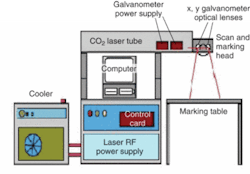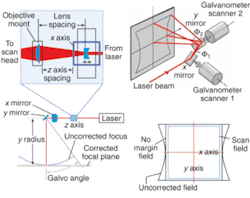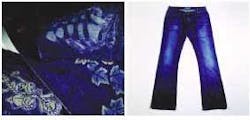The use of stone-washing and bleaching to create surface effects on fabrics is difficult to control and caustic. A novel machine uses laser-beam intensity variation to reproducibly modify the surface of fabrics without harming product quality.
Soon after blue-jean manufacturers started fading and tearing their product, jeans that looked strikingly “worn” became very popular and often commanded higher prices than jeans that looked brand new. Changing the visual characteristics of fabrics by applying designs and textures to their surfaces is a desired effect in the textile industry. However, the use of stone-washing or bleaching presents problems, including the inability to create reproducible designs, difficulty in applying the design processes to different fabrics, and loss of fabric quality after processing-not to mention toxicity of the chemicals involved. These time-consuming and nonstandard procedures create a significant barrier to mass production and increase cost, while decreasing the quality and added value of the product.
To address these problems, a novel system has been designed that does not have the drawbacks involved in stone-washing and bleaching methods. The system uses a laser beam to transfer graphics of desired variety, size, and intensity on all kinds of textile surfaces, including knitted or woven fabrics and leather, with precision and without damaging the texture of the material.
Machine components
The laser-surfacing machine transfers a gray-scale design to the textile surface using variations in intensity of the focused laser beam (see Fig. 1). A variety of patterns can be created in numerous fabric types by varying the laser intensity to change the dye molecules in the fabric and create alterations in its color. The process requires that the fabric be treated with a suitable dye material that changes color when exposed to the heat of the laser beam.
FIGURE 1. A fabric-surfacing machine uses a 100-W CO2 laser to transfer a gray-scale design to the surface of a textile using variations in intensity of the focused laser beam.
The machine uses either a 100- or 250-W CO2 laser emitting at 10.6 μm. A galvanometer, along with optics and lenses, is used for enlarging or reducing the laser beam for focusing on the desired point. The movement of the galvanometer and the laser is synchronized by a control card with 16-bit sensitivity and a high-speed servo-controlled exit. The movement of each axis (x and y) is divided into 65,535 individual steps. The wavelength and the power of the laser beam can vary according to the nature of the texture of the area where the design will be created, and adaptations can be made by adjustments to the source of the laser beam and to the optical lenses (see Fig. 2).
Operation
A trial application of the laser-surfacing machine was performed using blue-jean fabric of 100% cotton weighing 440 g/m2 with a weft count per centimeter of 21 and a warp count per centimeter of 27.
FIGURE 2. Two optical methods can be used in the system depending on laser power. For 250-W lasers, the beam is expanded in the z axis to prevent the x and y mirrors from overheating and suffering any damage. The thick-edged optical lens on the z axis moves back and forth to eliminate focusing disparities between the central point and the edges of the marking table to provide an equal level of burning in the center and on the edges of the pattern area when the beam is applied (left). For 100-W lasers, f theta lenses with variable focusing distance can be used. Instead of a z axis, these systems are equipped with a continuous beam-expanding ability. After passing through the x and y mirror, the laser beam reaches the f theta lens, which makes the focusing distance between the central point and edges equal, in effect performing the function of the z axis (right, top). The beam reflecting upon the x and y mirrors pass onto the other axis without changing its direction. Depending on the movement of the mirrors, the rastering area expands toward the edges, and undesired expansions can be corrected using the program (right, bottom).
First, a bitmap of the pattern to be applied is prepared using a software program. The pattern to be applied can contain up to 256 gray tones. The pattern is then transferred to the laser textile-application (LST-TEX) program, which helps determine the size, printing sensitivity, and intensity of the pattern. At the start of the marking process the computer transforms the pattern into the vector format of the control card and then loads the information into memory. The pattern goes through a preliminary interface program and is then kept in the form of scanner vectors. Horizontal and vertical axes coordinates are formed using the same interface software and then transferred to the digital transforming cards. All these operations are completed within a period of 100 to 300 μs.
After the loading process the marking begins. The mechanical device developed to adjust the dimension of the image controls the intensity of the laser beam. The laser beam can be modulated in 256 different shades applied between the lightest area and the darkest for a single point according to the scanning time (from 1/256 to 256/256) of the laser, which is operated within the 0- to 100‑KHz range. All these operations (movement on x and y axes and modulation of the laser beam) must be synchronized to accurately print the pattern. The time of the printing operation depends on several factors, including the size of the image, printing sensitivity, and printing intensity. If these parameters increase in value, so does the printing time.
The system can also be used to create wrinkling and three-dimensional features by deforming the fabric via heating effects. The same heating mechanism can also be used to create designs through fabric cutting.
Results
In the prototype system, 256 photographic images in gray tones were transferred onto various textile surfaces using a 100-W CO2 laser source and adjusting the initial power-impact width. Transferring the image onto a 100 × 100-mm textile surface takes 5 to 20 seconds (depending on the intensity) using the interface program that was developed for this procedure. The results show that the laser surface-design machine can be used successfully on a wide variety of textile surfaces, from synthetic curtain fabrics to denim, and from artificial to genuine leather (see Fig. 3).
Designs are not limited to two-dimensional images. A deliberate deformation can be created on the textile surface by increasing or decreasing the power of the laser beam under controlled conditions, allowing three-dimensional surface designs. The laser surface-design machine enriches the aesthetic quality of the finished product without altering fabric quality and without requiring the harsh chemicals often used in other surface-altering techniques.
REFERENCES
1. T. Bahners et al., Applied Surface Science 69, 1, 12 (1993).
2. M. Ortiz-Morales et al., Laser Marking and Lasers in Engineering 39, 15 (2003).
ZIYNET ONDOGANand OKTAY PAMUKare Engineering Faculty from the Textile Engineering Department, and TAYFUN DALBASTIis a member of the neurosurgery medical faculty at Ege University in Bornova-Izmir, Turkey 35100; e-mail: [email protected].HUSEYIN AYDINandMELIH OZCELIKare Scientists from the Cagil Electronic Company in Izmir, Turkey.


